
f12 SSB
conversion for surplus receivers - part I
(part two = f13.htm)
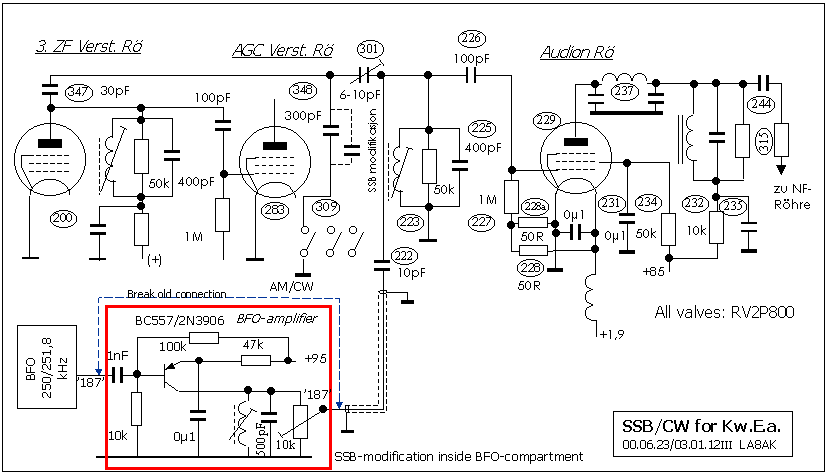
2q AM/CW/SSB
detector in Kw.E.a is the Audion-type.
The circuit diagrams shows that only the BFO unit is modified for
SSB, but only a small circuit
is added, and it is easily converted back to the original state.
It is however, an advantage to
decrease the IF level to the detector in CW/SSB mode further with
an additional capacitor
across '348' 300pF capacitor
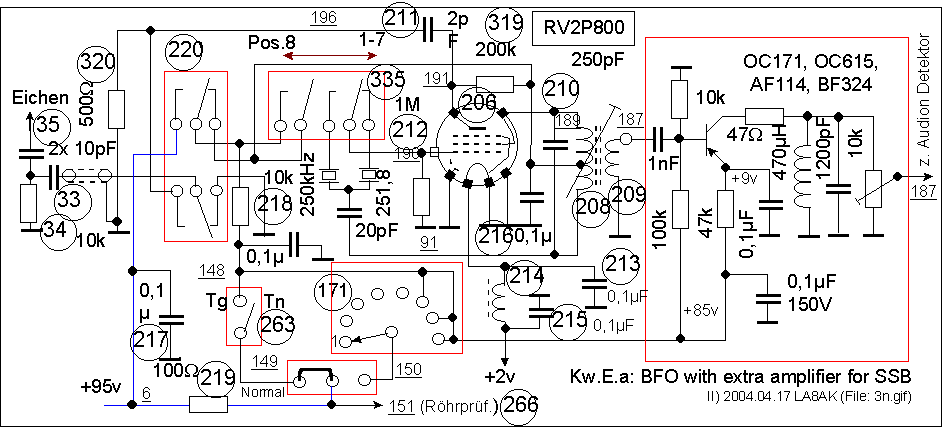
BFO circuit in Kw.E.a.
It is quite complex and not really easy to read the circuit
diagram. Different version of circuits
shows different details, so some may be wrong, but it is
difficult to say without closer inspection
into the receiver.
The same notes are also mentioned on page 22r
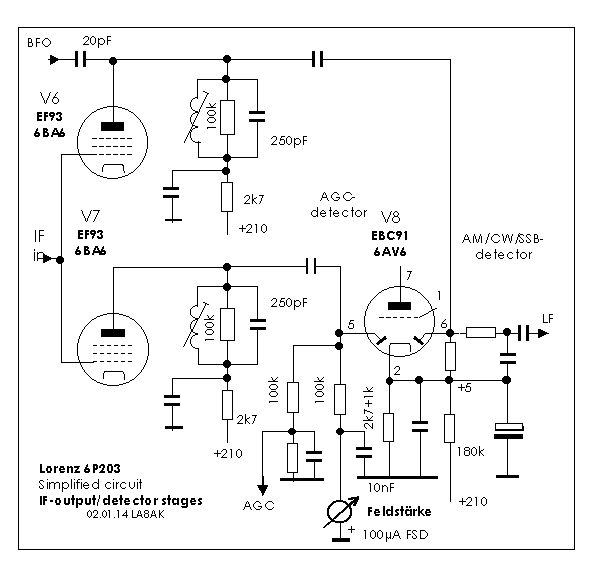 |
Lorenz 6P203 receiver; detectors
Note that the IF is splitted, with two different last IF
stages, one for CW/SSB detector and
another for AGC, so it is no problem to receive CW/SSB with AGC
on. The only modification
needed, was to change the anode resistor for BFO from 220k to 33k
to increase the anode
current and increase the BFO injection. Used it on many evenings
listening to 3800kc, and I
am surprised that the audio quality for ssb is so well. Audio
output stage is a 6AU6/EF94. The
receiver has also a remarkable good audio cw filter with
bandwidth down to 0.3kHz.
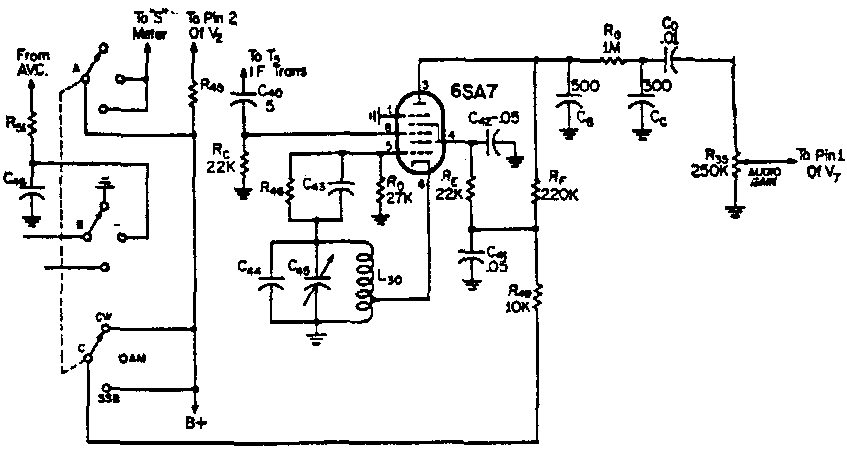
W5UOZ's product detector for HQ-129X
(Hammarlund).(See CQ April 63) This was
an important note to read, and may have changed my opinion
towards thinking about "choosing
the proper circuit for the specific receiver" .
Since the original BFO is an Electron-coupled type, I would use
Hartley or Colpitts type oscillator!
To much equipment has been damaged by silly persons who decided
to modifiy it but never
really found the solution to fulfil it. The receiver would be
wrecked and never operated again.
In some cases such receivers are seen at auctions, but most are
just put in the garbage. In the
actual application it is much attenuation in the output circuit.
It is probably better to use a proper
audio low pass filter and risk to have more attenutation at the
input, possibly adding a resistor in
series with the input since small coupling capacitors are only an
indication of an amateur who
really doesn't know what he is doing, see the next circuit
diagram for a similar stage, but
proffessional design.
The best idea is keep the oscillator type, and use the suitable
product detector which goes
with it. If the original BFO is a Hartley or Colpitt type, the
best idea is to replace the BFO valve
with a 6AJ8/ECH81 or 6K8/ECH35.
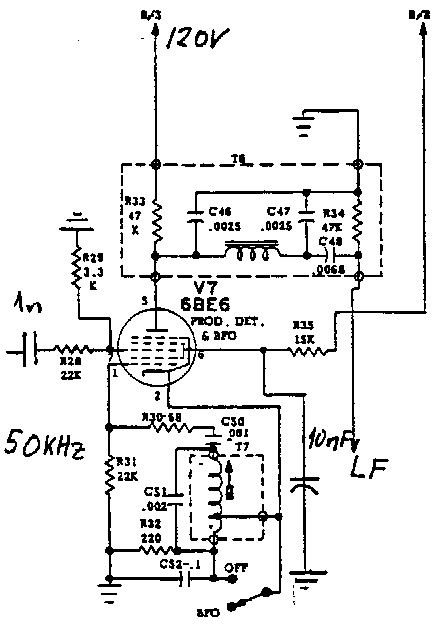
Another well-proven circuit is used in Drake receivers, this is
from the 2-B, it may well be used with
6SA7 instead.
In some cases the BFO causes more problems than the lack of
product detector. For Hallicrafters
S-40A the BFO drifts a lot, but I cured it by using a half watt
grid leak resistor.
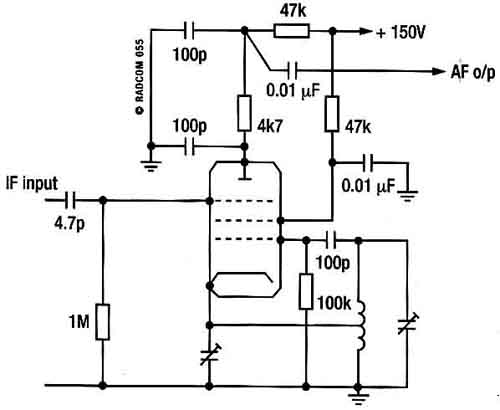
For his HRO, G3RZP fitted a simple product detector/BFO. He used
a 6SJ7, but virtually any pentode
would be suitable. This arrangement prove suitable for fitting
into almost any of the vintage 'boatanchor'
receivers designed before introduction of amateur SSB. It has the
advantage for all modes over diode
detector which require volts of input to minimize distortion. But
still IF level must be reduced for proper
ssb operation! See Technical topics G3VA, Radcom, January 2004,
pg 45.
The concept is certainly not suitable for any receiver, only the
receivers where the original BFO uses
ECO circuit, so if it is grid/anode-connected you still need to
use the next suggested circuit as forAR-88.
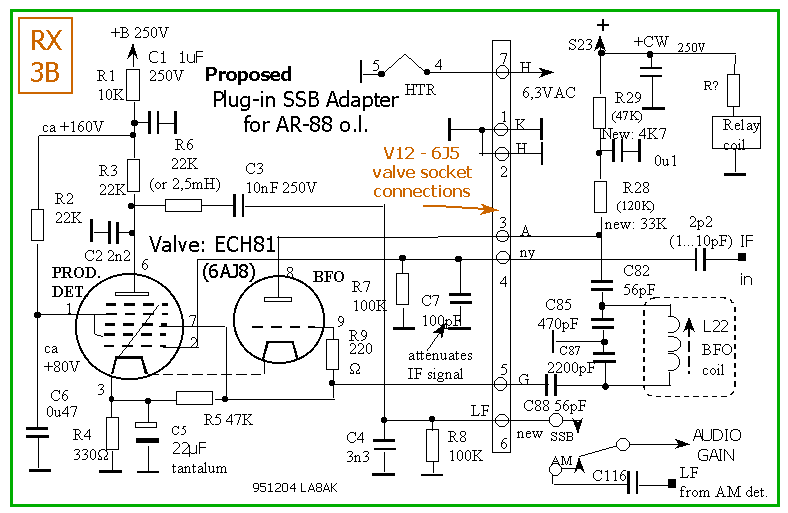
Plug-in Product detector for AR-88 (RCA) and
similar receivers
Before you start thinking about how to
construct an SSB adapter or modification for your receiver,
it is most important to see which type BFO is used. If is is an
ECO type, then 6SA7 or 6BE6 type
converter may be the most suitable for conversion, but it is a
Hartley or grid-to-anode type Colpitts
oscillator then you must use 6K8, ECH35, ECH81/6AJ8 or similar
triode/heptode, the latter applies
for AR-88. Too many modifications changes uneccessarily much and
it is no good way, the more you
change the less is the chance for success, and it is even harder
to finish, so it is often most likely the
receiver is wrecked and dumped next the year.
It is a suggested circuit diagram if you don't wish to modify the
receiver more than it is always easy
to convert it back to the original state. I've studied the
circuit diagram to see if it is possible to build
a PLUG-IN adapter which goes on to the original BFO valve socket
and only minor wiring changes
are made, they are probably not much important if you wish to use
the receiver as it was before
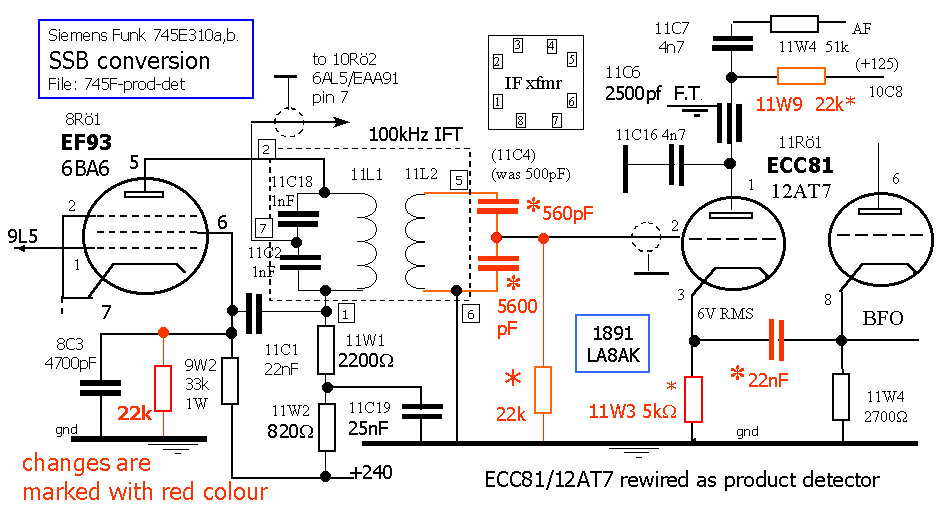
Siemens 745 E310 receiver
has 12AT7/ECC81 as detector/BFO, but it is useless
for SSB reception. It is relatively easy to modify it for proper
SSB reception by some simple changes,
it is some mechanical work, but no real challenge.The first step
is to reduce the input level to the
product detector so it is not overloaded by a normal IF level.
You must open the IF can and remove
11C4 capacitor, mount 560 and 5600pF capcitors underneath and
connect the center to the screened
cable going to the valve grid. A grid leak must also be added
since the grid is no longer grounded
through the coil. Then 11W3 is changed and a .02µF capacitor is
added between the cathodes.
11W9 is changed to 22k. The screen grid voltage for IF output
stage is stabilized for better AGC operation
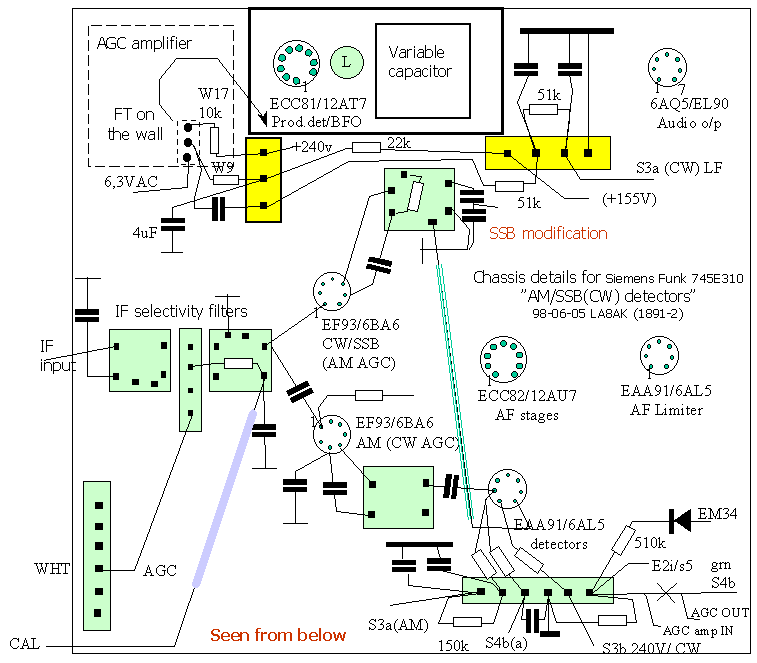
IF-stage chassis details for Siemens Funk 745 E310
receiver, the drawing shows parts mentioned
in the modifications mentioned above
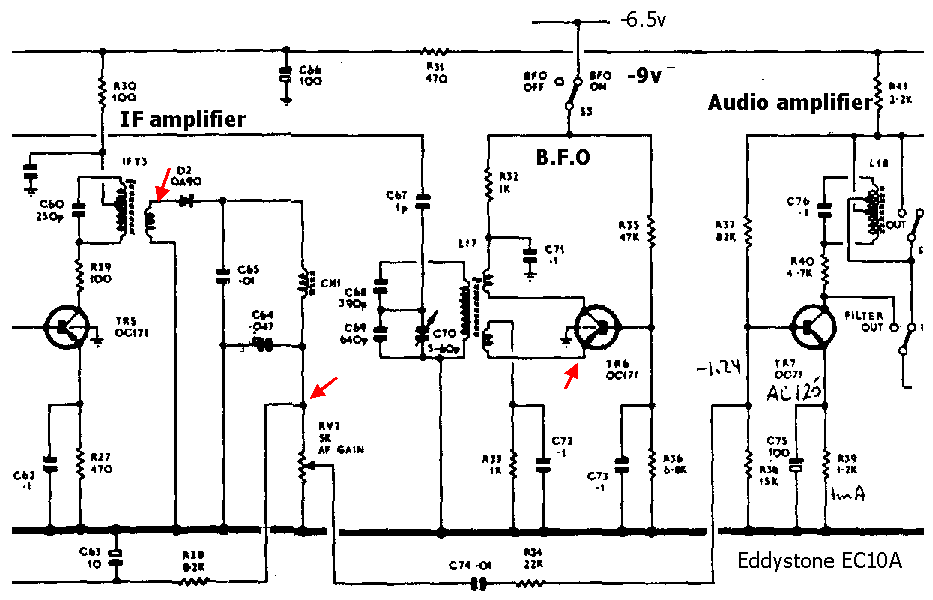
Eddystone EC10A Receiver: IF-output, detectors and 1st audio stage.
For some strange reason this receiver is not suitable for SSB. So
I was asked to convert one 16 years ago.
If I could have chosen, the product detector should have used
MC1496P, S042P or NE604. But in this
case it is difficult because
of the negative supply voltage, it would probably caused some
problems with suitable decoupling.
A DG-mosfet seems easier to use. BFO injection is adjusted for
3-4V drain voltage (ca. 2mA drain current).
To avoid selfoscillation in the IF, audio cables should be
screened such that they don't radiate signal back
to a critical point in the IF..
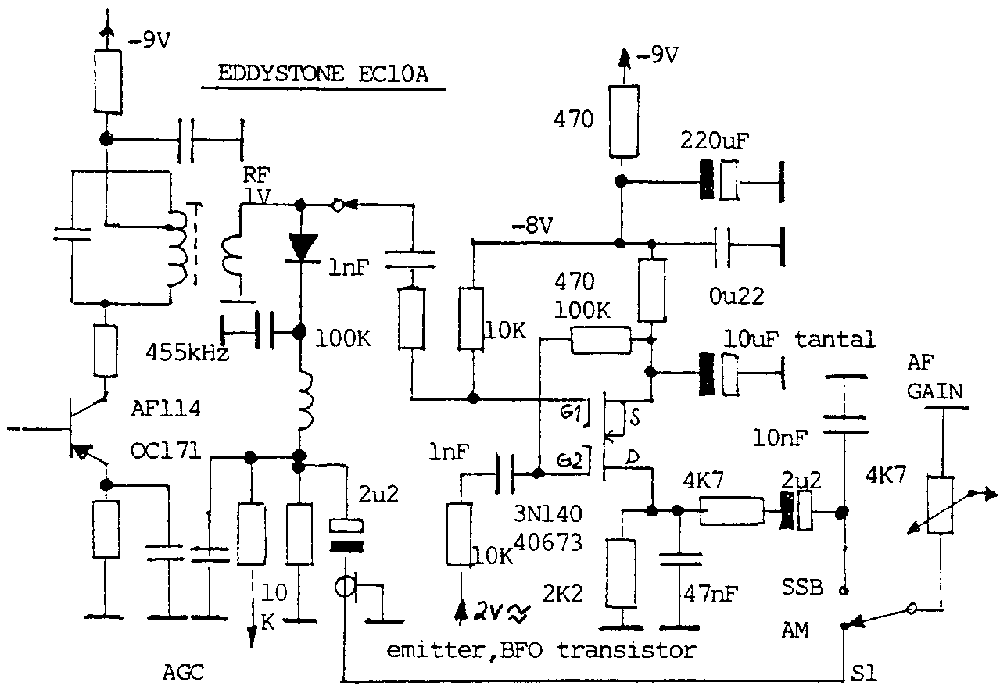
Product detector for Eddystone EC10A solidstate
receiver using 3N140 or 40673 dual gate mosfet.
Remember to remove C67 such that BFO-signal does not go into the
IF when the product
detector is installed. If you should need to replace the audio
stage transistor, BC557 is a
suggested device, emitter resistor must be reduced to 680W .
förzer notes to come later
I enjoy collecting these
items and I will show them on my website for others to enjoy. I
am not interested in selling them, however - please do not ask.
Instead, I hope to help others who collect this type of gear and
would like to hear from them.
Last update: 2005.01.09